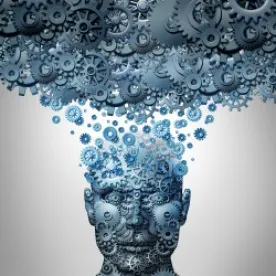The U.S. Copyright Office Review Board refused copyright protection of a two-dimensional artwork created by artificial intelligence, stating that “[c]urrently, ‘the Office will refuse to register a claim if it determines that a human being did not create the work,’” see recent letter. The Compendium of U.S. Copyright Office Practices does not explicitly address AI, but precedent, policy, and practice makes human authorship currently a prerequisite.
A “Creativity Machine,” authored the work titled “A Recent Entrance into Paradise.” The applicant, Steven Thaler, an advocate for AI IP rights, named himself as the copyright claimant. Thaler’s application included a unique transfer statement: “ownership of the machine,” and further explained that the work “was autonomously created by a computer algorithm running on a machine.” Thaler sought to register the work as a work-for-hire because he owns the Creativity Machine.
AI’s “kill switch” at the U.S. Copyright Office? AI isn’t human. The Review Board relied on the Office’s compendium of practices and Supreme Court precedent dating back to 1879—long before computers were a concept—to hold that the U.S. Copyright Office will not register a claim if it determines that a human being did not create the work.
The Review Board also denied Thaler’s argument that the work made for hire doctrine allows non-human persons like companies to be authors of copyrighted material. The Board explained that works made for hire must be prepared by “an employee” or by “parties” who “expressly agree in a written instrument” that the work is for hire.
Because Thaler did not claim any human involvement in the work, the Board did not address under which circumstances human involvement in machine-created works might meet the statutory requirements for copyright protection. This is an issue that may soon arise.
AI has brought about an important crossroads in copyright law. Humans have always used tools to create copyrightable works; copyrighted works have always been fixed in some tangible medium of expression. But what happens when the tools are no longer “just” tools, and they evolve into larger roles? And when the tools create valuable works, who reaps the benefits of that value? How can the law incentivize the creators of AI to continue to develop creative AI to produce valuable works of art, music, literature, and games?
In October 2018, a portrait created by AI sold for US$432,500 at Christie’s New York. The hefty price tag for the piece, “Edmond de Belamy, from La Famille de Belamy,” was more than double the purchase prices of Andy Warhol and Roy Lichtenstein prints available for sale in the same collection. The French collective that created the US$430,500 AI-generated piece, used a 19-year-old’s code and a pre-existing algorithm to create the artwork.
Google’s Google News Initiative uses AI to generate local new articles. A company called Deep Mind has created software that makes music. AI’s position in the marketplace for music, art, and publications is growing. An enormous amount of valuable works are at risk of plagiarism. While the Copyright Office just denied copyright protection to AI-only works, it may soon have an opportunity to decide the requisite amount of human involvement required to protected AI-contrived works.
Kristin Wells contributed to this story.




 />i
/>i
